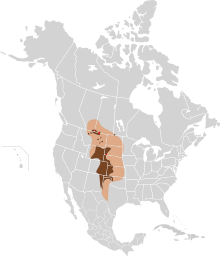
Back Vulpes velox AN ثعلب سريع Arabic ثعلب سريع ARZ Bresitol (Vulpes velox) AVK Vulpes velox BE-X-OLD Американска прерийна лисица Bulgarian Louarn ar plaenennoù Breton Guineu veloç Catalan Vulpes velox CEB Liška šedohnědá Czech
| Swift fox[1] | |
|---|---|

| |
| Swift fox at Colorado Wolf and Wildlife Rescue Center | |
| Scientific classification | |
| Domain: | Eukaryota |
| Kingdom: | Animalia |
| Phylum: | Chordata |
| Class: | Mammalia |
| Order: | Carnivora |
| Family: | Canidae |
| Genus: | Vulpes |
| Species: | V. velox
|
| Binomial name | |
| Vulpes velox (Say, 1823)
| |

| |
| Swift fox range | |
| Synonyms | |
| |
The swift fox (Vulpes velox) is a small light orange-tan fox around the size of a domestic cat found in the western grasslands of North America, such as Montana, Colorado, New Mexico, Kansas, Oklahoma[3] and Texas.[1] It also lives in southern Manitoba, Saskatchewan and Alberta in Canada, where it was previously extirpated.[2] It is closely related to the kit fox (V. macrotis) and some mammalogists classify them as conspecific.[4] However, molecular systematics imply that the two species are distinct.[5] Interbreeding between the two species does occur where their ranges overlap (eastern New Mexico and western Texas), but this hybridization is quite restricted in scope.[6]
The swift fox lives primarily in short-grass prairies and deserts. It became nearly extinct in the 1930s as a result of predator control programs, but was successfully reintroduced later. Currently, the conservation status of the species is considered by the IUCN as Least Concern owing to stable populations elsewhere.[2]
Like most canids, the swift fox is an omnivore, and its diet includes grasses and fruits as well as small mammals, carrion, and insects. In the wild, its lifespan is 3 to 6 years, and it breeds once annually, from late December to March, depending on the geographic region. Pups are born anywhere from March to mid-May, and are weaned at six to seven weeks old.
- ^ a b Wozencraft, W. C. (2005). "Order Carnivora". In Wilson, D. E.; Reeder, D. M. (eds.). Mammal Species of the World: A Taxonomic and Geographic Reference (3rd ed.). Johns Hopkins University Press. pp. 532–628. ISBN 978-0-8018-8221-0. OCLC 62265494.
- ^ a b c Moehrenschlager, A.; Sovada, M. (2016). "Vulpes velox". IUCN Red List of Threatened Species. 2016: e.T23059A57629306. doi:10.2305/IUCN.UK.2016-3.RLTS.T23059A57629306.en. Retrieved 19 November 2021.
- ^ Caire, William (1989). The Mammals of Oklahoma. The University of Oklahoma Press. pp. 30, 288–291. ISBN 978-0806122175.
- ^ Dragoo, Jerry W.; Choate, Jerry R.; Yates, Terry L.; O'Farrell, Thomas P. (August 28, 1990). "Evolutionary and Taxonomic Relationships among North American Arid-Land Foxes". Journal of Mammalogy. 71 (3): 318–332. doi:10.2307/1381942. JSTOR 1381942. Retrieved 22 December 2021.
- ^ Mercure, Alan; Ralls, Katherine; Koepfli, Klaus P.; Wayne, Robert K. (1993). "Genetic Subdivisions among Small Canids: Mitochondrial DNA Differentiation of Swift, Kit, and Arctic Foxes". Evolution. 47 (5): 1313–1328. doi:10.2307/2410150. JSTOR 2410150. PMID 28564903.
- ^ Sheldon, Jennifer W. (1992). Wild dogs: the natural history of the non-domestic Canidae. San Diego: Academic Press. pp. 176–182. ISBN 9781483263694.
